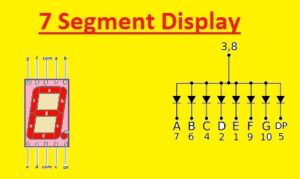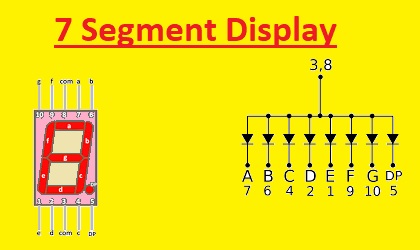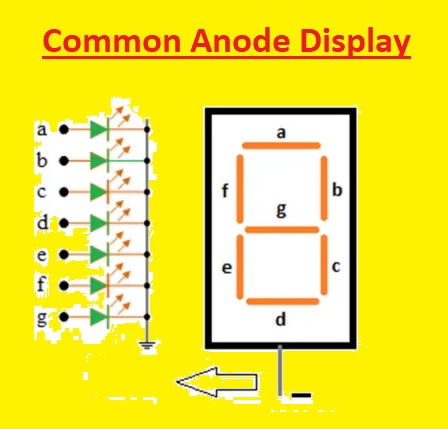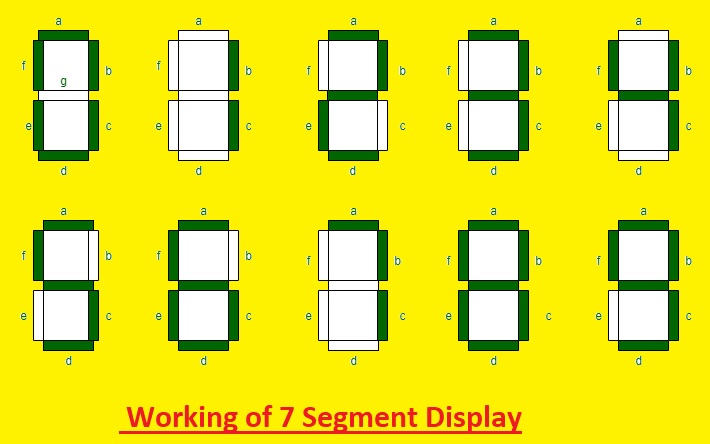Table of Contents
ToggleWhat is a 7-segment display pinout?
The seven-segment display is a type of electronic display used for displaying decimals and numerals that is the replacement for complicated dot matrix displays. It is commonly used in digital clocks, electronic meters, and calculators, as well as in different devices that display numerical data. In this post, we will discuss its pinout, features, working, and other parameters. So let’s get started with an introduction to the 7-segment display pinout.
Pinout of 7-Segment Display
- The 7-segment display comes with 7 LEDs connected to an 8-number structure. Each segment has certain labels: A, B, C, D, E, F, and G. Pins according to letters are mentioned at the back side of the display.
| Pin Number | Pin Name | Description |
| 1 | A | It controls the left lower part of the display |
| 2 | D | It controls the lower part of 7 7-segment display |
| 3 | Com | Connected to Ground/VCC |
| 4 | C | right bottom LED controlled |
| 5 | DP | decimal point LED regulated |
| 6 | B | The upper right LED of the 7-segment display controlled |
| 7 | A | The top part of the LED of the 7-segment display controlled |
| 8 | Com | Connected to Ground/Vcc |
| 9 | F | top left LED-controlled |
| 10 | G | the middle LED of the display controlled |
7-Segment Display Pinout Working Description
The use of a 7-segment display is easy. Contrary to other modules, the 7-segment display can be made without the use of a microcontroller or a microprocessor.
This configuration is possible due to the use of 7-segment counter ICs such as IC CD4026.
This IC is used in combination with a display for projects that come with simple circuits.
The IC can operate a single 7-segment display, and the number that is shown is also incremented or decremented.
It is common that a 7-segment display is used with an MCU/MPU; in that condition, 7-segment pins will be connected to I/O pins of microcontrollers, and compin is connected with ground Vcc based on type.
These I/O pins can be toggled in certain sequences to show the required number.
Here is a table made to show the sequence.
To display every number in a 7-segment display, it has the sequence as shown in the table.
If there is a need to show zero, we require the glow of all LEDs except the LED that is connected to g with the bit pattern tern 11000000. For showing 1 digit to glow, the LED related to b and c will glow, and the bit pattern will be 11111001.
| Digits | h g f e d c b a | Hex code |
| 0 | 1 1 0 0 0 0 0 0 | C0 |
| 1 | 1 1 1 1 1 0 0 1 | F9 |
| 2 | 1 0 1 0 0 1 0 0 | A4 |
| 3 | 1 0 1 1 0 0 0 0 | B0 |
| 4 | 1 0 0 1 1 0 0 1 | 99 |
| 5 | 1 0 0 1 0 0 1 0 | 92 |
| 6 | 1 0 0 0 0 0 1 0 | 82 |
| 7 | 1 1 1 1 1 0 0 0 | F8 |
| 8 | 1 0 0 0 0 0 0 0 | 80 |
| 9 | 1 0 0 1 0 0 0 0 | 90 |
Types of 7-Segment Displays
- There are two main types of 7-segment display. There are two types of 7-segment displays: The first one is common anode, and the second one is common cathode.
Common Anode 7-Segment Display
- The common anode display is called the CA display. In this type of display, the common pin on the 7-segment display is connected with all 8 anode pins of LEDs. To make 7-segment displays operate, we connect the Com pin with VCC +5V typically and ground the segment pin to turn it on.
Common Cathode 7 Segment Display
- Common cathode display called CC display. In this display common pin 7 segment display is connected with 8th cathode pins of LED. To make this display to work connect the Com pin with the ground pin and power connected with other pins through Vcc about five volts.
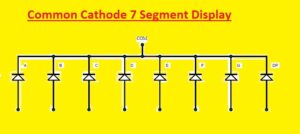
Specifications of 7-Segment Display
- There are some important specifications of a 7-segment display that are explained.
- It has two modes: the first one is the common cathode, and the second one is the common anode.
- It has many sizes, such as 9.14 mm, 38.10 mm, 57.0 mm, 14.20 mm, 20.40 mm, and 100 mm, and the common size is 14.20 mm.
- It has different colors, such as white, blue, red (mostly used), yellow, and green.
- It has a low current operation.
- Its peak current is about 70 mA.
- It has good brightness and a larger display than older LCDs.
- It uses about 30 mA/segment.
7-Segment Display Codes
| Number | g f e d c b a | Hex code |
| 0 | 1,000,000 | C0 |
| 1 | 1111001 | F9 |
| 2 | 100100 | A4 |
| 3 | 110000 | B0 |
| 4 | 11001 | 99 |
| 5 | 10010 | 92 |
| 6 | 10 | 82 |
| 7 | 1111000 | F8 |
| 8 | 0 | 80 |
| 9 | 10000 | 90 |
Working of 7-Segment Display
- The working of this component is very simple. If voltage is applied to certain LED segments of the display, it gets on, and a correspondent character or number is displayed. Through accurate on and off of LED segments, any special number of characters can be displayed.
- The number 8 is shown when power is connected to all segments, and if we disconnect power for g, this shows a zero number. In the 7-segment display,make a combination of display numerals from zero to nine. power for different pins is given at the same time. We can make a combination of display numerals from zero to nine.
- As the 7-segment display does not make letters such as X and Z, it cannot be used for the alphabet and can be used for showing decimal numbers.
- Seven-segment displays can make alphabets A, B, C, D, E, and F. So it is used to show the display unit normally comes with a dot point. The display point can exist towards the left or right of the display pattern.
- That pattern is used to show numbers from zero to nine and letters from A to F hexadecimal digits.
7-Segment Display Truth Table
| Input | a | b | c | d | e | f | g |
| 0 | 0 | 0 | 0 | 0 | 0 | 0 | 0 |
| 1 | 0 | 1 | `1 | 0 | 0 | 0 | 0 |
| 2 | 1 | 0 | 0 | 1 | 1 | 0 | 1 |
| 3 | 1 | 1 | 1 | 1 | 0 | 0 | 1 |
| 4 | 0 | 1 | 1 | 0 | 1 | 1 | 1 |
| 5 | 1 | 0 | 1 | 1 | 0 | 1 | 1 |
| 6 | 1 | 0 | 1 | 1 | 1 | 1 | 1 |
| 7 | 1 | 1 | 1 | 0 | 0 | 0 | 0 |
| 8 | 1 | 1 | 1 | 1 | 1 | 1 | 1 |
| 9 | 1 | 1 | 1 | 1 | 0 | 1 | 1 |
4 Digit 7 Segment Display Truth Table
- The 4-digit 7-segment display comes with 4 distinct digits and each digit has 7 segments that can be ON or OFF for showing numbers and letters
- Here you can see the truth table for a 4-digit 7-segment display
| Digit | A | B | C | D | E | F | G |
| 0 | 1 | 1 | 1 | 1 | 1 | 1 | 0 |
| 1 | 0 | 1 | 1 | 0 | 0 | 0 | 0 |
| 2 | 1 | 1 | 0 | 1 | 1 | 0 | 1 |
| 3 | 1 | 1 | 1 | 1 | 0 | 0 | 1 |
| 4 | 0 | 1 | 1 | 0 | 0 | 1 | 1 |
| 5 | 1 | 0 | 1 | 1 | 0 | 1 | 1 |
| 6 | 1 | 0 | 1 | 1 | 1 | 1 | 1 |
| 7 | 1 | 1 | 1 | 0 | 0 | 0 | 0 |
| 8 | 1 | 1 | 1 | 1 | 1 | 1 | 1 |
| 9 | 1 | 1 | 1 | 1 | 0 | 1 | 1 |
7-Segment Display Circuit Diagram
- The 7-segment display comes with seven LEDs that are denoted as A to G, with that common anode or common cathode configuration used to connect all 7 segments.
- Every LED is connected with a single pin on the controller or other digital circuits that are set to define low or high voltage for on and off LEDs.
- The controller sends a signal to any pin of the desired segment. Such as shown digit 1, the controller sends a signal to B and C LEDs.
- For digit five, the display signal will move to the A, C, D, F, and G segments.
- 7-segment display not only displays digits but also shows letters and characters with the use of different combinations of LED segments.
- For showing decimal points, some less have the 8th LED segment.
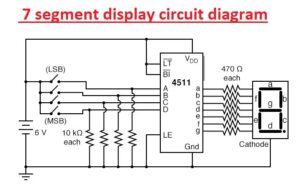
Applications of 7-Segment Displays
- It was used for projects that needed to show a larger font size.
- It has high brightness and is used for showing work in low light or less light.
- It’s working not based on a microcontroller, so it can be used for small circuit projects.
- It is used with a combination of 4 segments to show sensor value with 4 characters.
Advantages of Seven-Segment Displays:
- Seven-segment presentations are normally modest and need the least components to operate as compared to different LCDs or LEDs.
- Seven-segment displays have high preservability also in low-light modules since they are used for high-contrast light in certain uses that are not difficult to work.
- It is a long-term operating device that is used in devices that operate under different temperature values and mechanical pressures.
Disadvantages of Seven-Segment Displays
- It only shows digits and characters, which makes its uses limited for some uses.
- It has limited survey points, and it is difficult to show certain points.
- It uses more power than different display devices, as they generate light regularly, which can affect devices.
- It has limited customization.
Read Also:
- Difference between LCD and OLED
- Difference Between LED & LCD
- Full Form of LCD, Working, Types, Features & Applications
- Global Rigid-flex PCB Market Progression Size
- AGM vs STD Battery: Which Is Better For Your Car?
FAQs
What is the definition of a 7-segment display?
- The 7-segment display is a type of electronic display device that shows decimal numbers that is replaced by a more complex dot matrix display. 7-segment displays are used in digital clocks, electronic meters, calculators, and other devices that display numerical details.
Write the Main Types of 7-Segment Displays.
- There are two types of LED 7-segment displays: the first one is the common cathode, and the second one is the common anode. The difference between these two types is that the common cathode has all cathodes of 7 segments connected with each other, and in the common anode type, all anodes are connected.
How Does a 7-Segment Display Work?
- The working of a 7-segment display is easy and comes with the activation of accurate segments to make required characters. The controller, like the controller ICs, controls the current passing through single LEDs based on the digit or character to be shown.
What are the specifications of a 7-segment display?
- It has two modes of operation: common cathode and common anode.
- Its peak current is seventy milliamperes.
- It uses thirty milliamperes of current.
- It comes with a good and larger size display than an LCD.
- Its main colors are white, blue, red, yellow, and green.
- its sizes are 9.14 mm, 38.10 mm, 57.0 mm, 14.20 mm, 20.40 mm, and 100 mm.
What are the applications of 7-segment displays?
- Seven-segment displays are used in digital clocks, basic calculators, displays electronic meters, , cars, and some other electronic devices that display numericals.
What is a 7-segment display?
- The seven-segment display is the type of electronic display device that shows decimal numbers that is an alternative to complex dot matrix displays. It is used in digital clocks, electronic meters, and other devices.
What is the 7-segment display algorithm?
- The seven segments are used to show numbers. Provides an array of n natural numbers. The operation is to find numbers in an array that used fewer segments to show numbers. If any number comes with the least number of segments, the output number has a small index.
What is a DP 7-segment display?
- It is an electronic display device used for displaying decimal numbers. Used for digital clocks and known as a seven-segment indicator,
Is it a 7-segment LED or LCD?
- The 7-segment LED is a digital display module used to show numerical data. LEDs arranged in the shape of numbers provide an easily seen display. They are known as “seven-segment displays” or “seven-segment indicators.
What is a 7-segment display, Arduino?
- Normally, a 7-segment display is a single unit that shows one digit or character. More digits are shown by multiplexing single-unit 7-segment displays with each other to make a two-digit display, a 3-digit display, or a 4-digit 7-segment display. It is easy to interface an Arduino and a 7-segment display together.
How many segments in a 7-segment display?
- The 7-segment display is an electronic device that comes with 7 LEDs configured in a rectangle shape. Every LED is known as a segment that is configured to one of the terminals A through G.
How does a 7-segment display decoder work?
- The 7-segment decoder that comes with 4 input lines and 7 output lines (a, b, c, d, e, f, and g) gets this BCD (A, B, C, and D) input. The output is given to a 7-segment LED display that has a decimal number based on inputs.
How to make a 7-segment LED display?
- In the circuit, every anode terminal of the common cathode LED display is configured directly to 4511 decoders through a current-limiting resistor. The cathodes of every LED are internally configured with the ground. The binary inputs A, B, C, and D with 4511 are via 4 mechanical ON/OFF switches.
